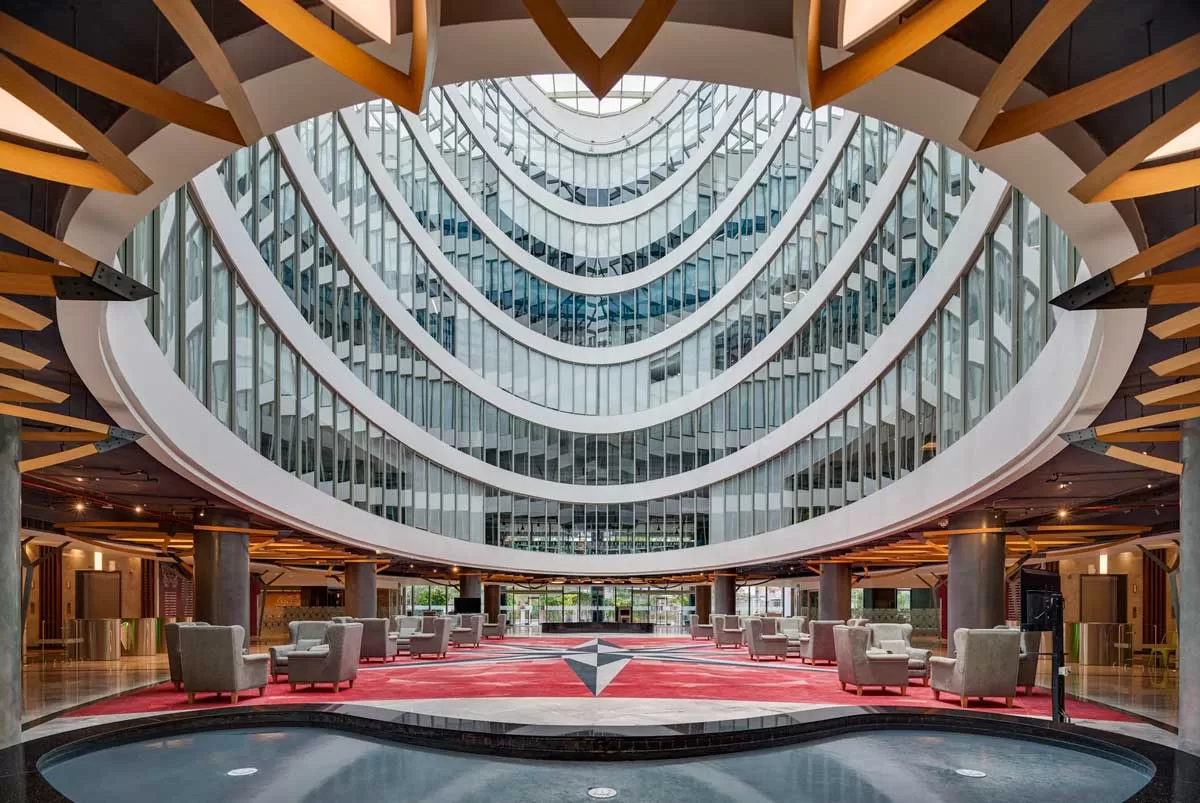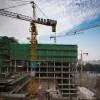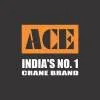In modern buildings, glass, when used in façades, is not just a material that wraps the exterior of a building but also one that contributes to the structure’s visual aesthetics, daylight penetration, and sound and heat insulation, observes Pranav Kareer, Senior Manager – Design, DLF India. This has been made possible
by the availability of high-performance glass with aesthetics-enhancing visual light transmission and reflection properties.
“Innovations in glass façade technology have transformed the way we design, construct and experience buildings,” says
Tushar Joshi, Founder, Utkarsh Vastukaran. “It is up to designers to select the right façade element and accommodate it intelligently
in the design.”
Within buildings, glass serves as an ideal material for partitions, dividers, wall highlighters and internal glazing, adds Kareer.
“Recent advancements in glass technology have led to the development of acoustic laminated glass, which reduces sound transmission, and transparent touchscreens, interactive projections and LED-embedded glass panels, which can transform glass façades into dynamic and engaging displays,” points out Joshi. “Advances in energy modelling have digitised and streamlined calculations for metrics such as the annual calculation of
sunlight exposure and spatial daylight autonomy.”
CW explores how architects and designers are making use of
these developments.
An environment-friendly
glass façade
A project by Rajinder Kumar & Associates (RKA), the Punjab National Bank corporate office in Sector 10, Dwarka, New Delhi, is one of the ‘greenest’ buildings in the NCR, spread over 4.8 acre and 8,25,000 sq ft.
The lead architect for this project, Rahul Kumar, Principal Architect, RKA, designed the office spaces as two ‘L’-shaped blocks around a great central atrium that is open from the sides towards the north and south, allowing for ample natural light and ventilation. At the central axis of this atrium is a unique tubular glass structure that incorporates double height spaces at every two levels. It houses a gallery/museum, a strategic war room for senior executives and special conferencing facility for visitors. This unique structure is shaded by a smart solar roof that covers the entire central space, allowing in natural light but also cutting the strong glare of the sun, and providing the bulk of the electricity required to run
the headquarters.
The building entrance is at a higher level that enables visitors to look down into the central atrium and it allows the space to be used as a large gathering point for a town hall. This further expands the space for multiple cafeterias, training rooms and an auditorium at the lowest level. Cavity walls with insulation are found all around the periphery combined with deep recessed windows on the
southern side.
“The use of intelligent and high-performance, double-insulated glass significantly brings down the temperature of the facility and working spaces,” shares Kumar. “The entire building form and façade has been designed keeping in mind the movement of the sun and the wind direction resulting in a very cool internal environment that is practical even in the harsh summer of Delhi, thus creating a very attractive working environment for the bank’s employees.”
Enhancing inside-out and outside-in views
The Brigade Group’s Brigade Tech Garden is a campus containing many office buildings arranged around a large central courtyard that runs through the length of the entire site. This green lung is where office users meet, congregate and interact. According to Ajay Koshy, Head, Design
& Development, Brigade Group, building faces looking onto this court have the most glazing (glass façades) to enhance the inside-out and exterior views.
“The choice of vision glass as a façade was also driven by the desire to bring in natural light and design a building that looks modern, contemporary and trendy,” says Koshy. “Several building glass protrusions accentuate and encourage the feeling of closer interaction while blurring the boundaries between the inside
and outside.”
“The glass was chosen to balance maximum transparency and solar coefficients, reduce heat gain and help obtain LEED Platinum rating for the project,” he adds. “Used in limited areas and intelligently, solar-controlled glass helps in thermal control and energy-efficiency. Its multiple colours and shades with varied reflections help create aesthetic, appealing and interesting façades.”
Curved glass façades
Callison USA, the architect of the AM Naik Tower in Mumbai, envisioned the 15-storey corporate office of L&T with a glass façade. Façade specialist Rajan Govind, Director, BES Consultants, came onboard the project and designed a bespoke facade that integrated unitised glazing with terracotta cladding fins. All the corners of the building feature curved glazing.
“We opted for terracotta panels because they lend the façade character and also stand out as a ‘different’ material,” he shares. “The terracotta panels were
25-mm thick with an extruded hollow profile. We chose Saint Gobain’s SKN133 double-glazed, high-performance units.” SKN133 is from the brand’s COOL-LITE® series, which is solar control glass with thermal insulation properties.
The bespoke lobby facade is 10 m tall and uses a glass fin frameless system. “We wanted an elegant look for the lobby and also a simple design and unspoilt view,” explains Govind. The frameless glazing was patch-fixed for safety.
Glass block walls
Glass blocks, typically 8×8 inch and 3 inch thick, can be used in various configurations and colours, says Deepak Gupta, Principal Architect, D+R Design. “For instance, on the exterior, glass blocks can be integrated into a 4’×4’ window or arranged in patterns like two blocks by four blocks to form a clerestory opening, allowing natural light to enter above the lintel level. Glass blocks are naturally insulated as they are hollow and 3 inch thick.”
Durable glass panelling
At Select Citywalk mall in New Delhi, Vistasp Bhagwagar, Principal Architect & Managing Director, AVA Design Studio, opted to use Saint Gobain’s Planilaque lacquered glass in the washrooms.
“We were asked to renovate the washrooms and given a very short turnaround time,” he explains. “Instead of ripping off all the existing wall tiles, we clad the tiles with BWP ply and created an innovative colourful composition of 6-mm-thick lacquered glass. This is PU lacquer-based with high humidity resistance making it perfect for washrooms. We selected De Bono-like colours – black,
ultra-white, solar yellow, flame red and mint green – and combined them in a bright and peppy manner to create a smart and cutting-edge pattern. The only challenges we faced were handling the material as it is not toughened and cutting it precisely, which were well-managed with good technical support.”
Mosaic tiles complemented the setting; the ceiling was primarily moisture-resistant gypsum; and the flooring was a combination of stone and tiles. All the counters and separators were made of hard surfaces like Corian.
Six years later, the pattern is as attractive as when it was first installed, showing how a seemingly fragile material like glass can be durable and long-lasting in the most public of spaces. Today, Bhagwagar points out that Saint Gobain’s Planilaque lacquered glass is available in 27 shades and seven trends making it a very attractive material to use, especially as it goes through meticulous lacquer screening and testing and has precise controlled homogeneous coating to be completely bubble and blister free. Also, it offers the highest opacity levels.
Space-enriching glass wardrobe panels
Glass helps create a sense of openness and sophistication in indoor spaces, according to Abhishek Chadha, CEO
& Co-Founder, The KariGhars. “Glass provides a sleek and modern aesthetic that complements the overall theme in apartments featuring modern designs,
while also allowing light to flow freely, enhancing the room’s brightness and visual appeal.
The transparency of glass adds depth and dimension, making areas feel more spacious and inviting. This is especially very useful in small apartments.”
For these reasons, he extensively uses glass for wardrobes and
room dividers. “For one project, we used lacquered glass with frosted etching fitted into aluminium profiling for the wardrobe’s front panels,” he explains. “We designed the panels and got them made. The glass panels are 8 mm thick, ensuring durability and resistance to impact. Additionally, the glass is treated with an anti-glare coating to reduce reflections and improve visibility. Frosted glass sections were incorporated for added privacy and to provide a balance between openness and seclusion.”
For another project, Chadha used lacquered glass with a mirror and a metal profile.
Light-enhancing
glass partitions
Glass partition panels maintain an open feel while providing sound insulation and privacy, says Gupta. “In a residential project, the absence of natural windows in the living room presented a challenge. Adjacent to this living space was a kitchen wall. To solve the problem, we removed the wall abutting the kitchen and the living room and installed 10-mm frosted glass instead. This allowed light from the kitchen window to flow into the living room, significantly enhancing the natural light inside. The frosted glass also provided privacy while facilitating light transfer, showcasing how effectively glass can be used to brighten interior spaces.”
The divider of a walk-in closet
in one of Chadha’s projects
features gold foil sandwiched between fluted glass panels. The front sliders were made of acrylic sheet and lacquered glass fitted into an aluminium profile. “With glass, there is no limit to the design combinations you can come up with,” he says.
Glass skylights
brighten interiors
Skylights as architectural features need to have glass as
the top cover, says Gupta.
“While round skylights typically have a diameter of 2.5 ft with an additional 4-inch glass extension, rectangular and significantly larger skylights have also been designed using toughened glass from brands like Saint Gobain. For a hotel’s restaurant in Durgapur, we used 12-mm toughened glass skylights, ensuring ample natural light penetrates the space Additionally, we applied a
wood finish film to the supporting metal structure to achieve a wood-like appearance.”
Truly, there is no end to the possibilities when designing
with glass.





















